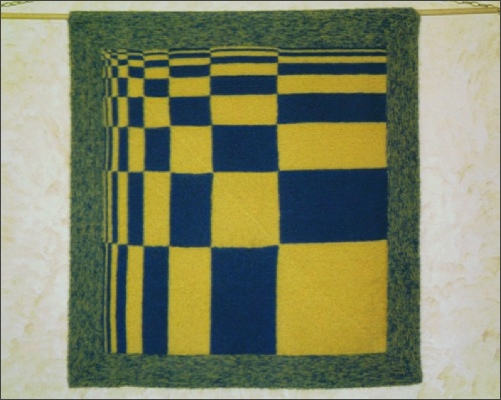




The Fibonacci sequence of numbers is well-
The sequence is named after Leonardo Fibonacci who lived around 800 years ago. He was also known as Leonardo of Pisa. The series is 0, 1, 1, 2, 3, 5, 8, 13, 21, 34, 55, 89...... Each term is found by adding together the two previous terms.
We had previously created many black and white op-
For Fibrenacci we chose the simplest form of using the sequence at the same scale in both directions.
The pieces are worked as a series of L shapes with a diagonal join from top left to bottom right. There were several ways it could have been made but all created difficulties with the smallest shapes at the outside edge. The yarns were used double and one strand of each colour was used for the border, creating a toning, though obviously different colour.
On one notable occasion I took Fibrenacci into school to use with a low-
We talked about squares, rectangles, alternating colours, the squares lying on the diagonal, etc. Then came the business of identifying the pattern of numbers. There was one extremely awkward and aggressive girl in the group who rarely put pen to paper in Maths lessons. I decided the safest place for Abida to be was at the front, counting the ridges. I was writing them on the board. The rest were trying to find a pattern of numbers.
When we had about six or seven terms on the board Abida suddenly flew across the room and hurled herself at another girl (as she was apt to do!). Plan failed? No! She merely wrestled a calculator from the seated girl, rushed off to her desk and, within seconds, gave us the next term from her calculator, without having to count.
Abida was reluctant to divulge how she did it but others eventually worked it out for themselves. She sat for the rest of the lesson generating more and more terms and, at the end of the lesson refused to leave (for which the next teacher was very grateful). She never caused a problem in Maths again!
